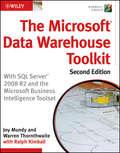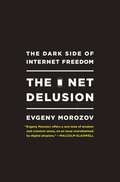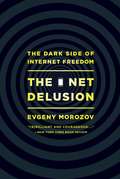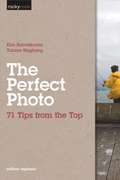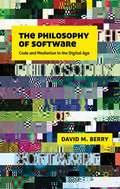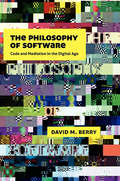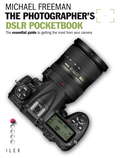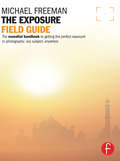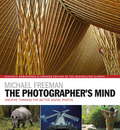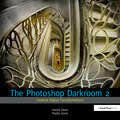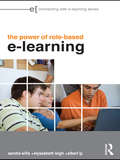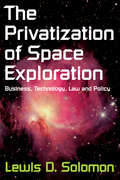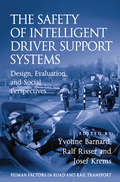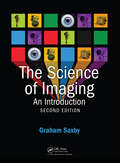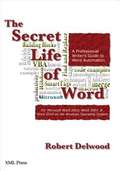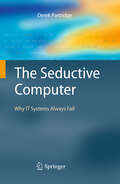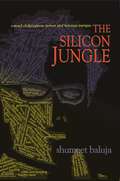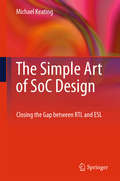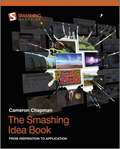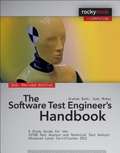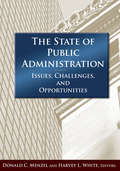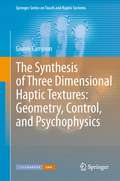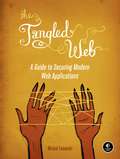- Table View
- List View
The Microsoft Data Warehouse Toolkit
by Joy Mundy Ralph Kimball Warren ThornthwaiteBest practices and invaluable advice from world-renowned data warehouse experts In this book, leading data warehouse experts from the Kimball Group share best practices for using the upcoming "Business Intelligence release" of SQL Server, referred to as SQL Server 2008 R2. In this new edition, the authors explain how SQL Server 2008 R2 provides a collection of powerful new tools that extend the power of its BI toolset to Excel and SharePoint users and they show how to use SQL Server to build a successful data warehouse that supports the business intelligence requirements that are common to most organizations. Covering the complete suite of data warehousing and BI tools that are part of SQL Server 2008 R2, as well as Microsoft Office, the authors walk you through a full project lifecycle, including design, development, deployment and maintenance. Features more than 50 percent new and revised material that covers the rich new feature set of the SQL Server 2008 R2 release, as well as the Office 2010 release Includes brand new content that focuses on PowerPivot for Excel and SharePoint, Master Data Services, and discusses updated capabilities of SQL Server Analysis, Integration, and Reporting Services Shares detailed case examples that clearly illustrate how to best apply the techniques described in the book The accompanying Web site contains all code samples as well as the sample database used throughout the case studies The Microsoft Data Warehouse Toolkit, Second Edition provides you with the knowledge of how and when to use BI tools such as Analysis Services and Integration Services to accomplish your most essential data warehousing tasks.
The Net Delusion
by Evgeny Morozov"The revolution will be Twittered!" declared journalist Andrew Sullivan after protests erupted in Iran in June 2009. Yet for all the talk about the democratizing power of the Internet, regimes in Iran and China are as stable and repressive as ever. In fact, authoritarian governments are effectively using the Internet to suppress free speech, hone their surveillance techniques, disseminate cutting-edge propaganda, and pacify their populations with digital entertainment. Could the recent Western obsession with promoting democracy by digital means backfire? In this spirited book, journalist and social commentator Evgeny Morozov shows that by falling for the supposedly democratizing nature of the Internet, Western do-gooders may have missed how it also entrenches dictators, threatens dissidents, and makes it harder--not easier--to promote democracy. Buzzwords like "21st-century statecraft" sound good in PowerPoint presentations, but the reality is that "digital diplomacy" requires just as much oversight and consideration as any other kind of diplomacy. Marshaling compelling evidence, Morozov shows why we must stop thinking of the Internet and social media as inherently liberating and why ambitious and seemingly noble initiatives like the promotion of "Internet freedom" might have disastrous implications for the future of democracy as a whole.
The Net Delusion
by Evgeny Morozov"The revolution will be Twittered!" declared journalist Andrew Sullivan after protests erupted in Iran in June 2009. Yet for all the talk about the democratizing power of the Internet, regimes in Iran and China are as stable and repressive as ever. In fact, authoritarian governments are effectively using the Internet to suppress free speech, hone their surveillance techniques, disseminate cutting-edge propaganda, and pacify their populations with digital entertainment. Could the recent Western obsession with promoting democracy by digital means backfire? In this spirited book, journalist and social commentator Evgeny Morozov shows that by falling for the supposedly democratizing nature of the Internet, Western do-gooders may have missed how it also entrenches dictators, threatens dissidents, and makes it harder--not easier--to promote democracy. Buzzwords like "21st-century statecraft" sound good in PowerPoint presentations, but the reality is that "digital diplomacy" requires just as much oversight and consideration as any other kind of diplomacy. Marshaling compelling evidence, Morozov shows why we must stop thinking of the Internet and social media as inherently liberating and why ambitious and seemingly noble initiatives like the promotion of "Internet freedom" might have disastrous implications for the future of democracy as a whole.
The Net Delusion: The Dark Side of Internet Freedom
by Evgeny MorozovEvgeny Morozov offers a rare note of wisdom and common sense, on an issue overwhelmed by digital utopians.
The Office Specialist
by The Office Specialist.com staffA workbook designed for middle and high school computer applications students who require Microsoft Office Software applications and its curriculum.
The Perfect Photo
by Elin Rantakrans Tobias Hagberg"Perfect" is a purely subjective term when it comes to art. A journey toward the perfect photo is a journey without a defined destination. There are photographs that are technically perfect and others that stand out because of their message or composition. Although the perfect photo remains a matter of taste, it is still something every photographer strives for. With this volume, Elin Rantakrans and Tobias Hagberg provide the beginning to intermediate photographer a wide range of practical tips that cover capture, composition, and editing--all with the aim of helping you achieve better photos. Each concept is illustrated with beautiful, inspiring images. Our promise: Use 7 of these 70 tips and you will be a 10% better photographer. Try it!
The Philosophy of Software
by David M. BerryThis book is a critical introduction to code and software that develops an understanding of its social and philosophical implications in the digital age. Written specifically for people interested in the subject from a non-technical background, the book provides a lively and interesting analysis of these new media forms.
The Philosophy of Software: Code and Mediation in the Digital Age
by D. BerryThis book is a critical introduction to code and software that develops an understanding of its social and philosophical implications in the digital age. Written specifically for people interested in the subject from a non-technical background, the book provides a lively and interesting analysis of these new media forms.
The Photographer's DSLR Pocketbook: The Essential Guide to Getting the Most from your Camera (Field Guide Ser.)
by Michael FreemanDigital SLR cameras have manuals running to hundreds of pages, concentrating on technical features, but neglecting the fact that great photographers not only know how to navigate menus: they understand how the operation of their camera will help them to take better pictures. 'The Photographer's DSLR Pocketbook' gives the reader the benefit of Michael Freeman's decades of professional photography and years of experience with digital technology. Opening with the anatomy of a digital SLR, the book then covers settings, exposure, capture and image workflow, clarifying the operations of your camera and allowing you to operate it with speed, confidence and accuracy.
The Photographer's Exposure Field Guide
by Michael FreemanFirst published in 2011. Routledge is an imprint of Taylor & Francis, an informa company.
The Photographer's Mind Remastered: Creative Thinking for Better Digital Photos (The Photographer's Eye #8)
by Michael FreemanYou've done your research. You've bought your camera. You've learnt how to use it. Now what? The secret behind a good photograph is not your camera. It's not even the scene viewed through the viewfinder. It's the mind of the photographer which turns an average photograph into an exceptional one. In The Photographer's Mind, professional photographer and author Michael Freeman unravels the mystery behind the creation of a photograph and reveals how to capture photos that really make you feel something.The aim of this book is to answer what makes a photograph great, and explore the ways that top photographers achieve this goal time and time again. The Photographer's Mind will provide you with invaluable knowledge on:· Avoiding cliché· The recurring nature of trends· Style and composition· Capturing light· How to handle the unexpected
The Photoshop Darkroom 2: Creative Digital Transformations
by Harold DavisAward-winning photography/design team Harold and Phyllis Davis are back with a brand new volume in their new Photoshop Darkroom series. Picking up where their best-selling first book left off, The Photoshop Darkroom 2: Advanced Digital Post-Processing will show you everything you need to know to take your digital imaging skills to the next level. Great photographers know that the best images begin well before the shutter clicks, and certainly well before Photoshop boots up. Harold takes a step back, and shares his helpful tips for capturing the most compelling images possible by keeping in mind what type of post-processing you'll do before you start shooting. You'll also find complete coverage of important topics such as compositing, working with layers, and HDR. Packed with tons of eye-popping images which have won Harold national acclaim, this is a fantastic resource for photographers who want to think outside the box and create truly stunning artwork.
The Power of Role-based e-Learning: Designing and Moderating Online Role Play (Connecting with E-learning)
by Elyssebeth Leigh Sandra Wills Albert IpWritten for educators seeking to engage students in collaboration and communication about authentic scenarios, The Power of Role-Based e-Learning offers helpful, accessible advice on the practice and research needed to design online role play. Drawing on the experiences of world-leading practitioners and citing an array of worldwide examples, it is a readable, non-technical, and comprehensive guide to the design, implementation, and evaluation of this exciting teaching approach. Issues discussed include: designing effective online role plays defining games, simulations and role plays moderating engaging and authentic role-based e-learning activities assessment and evaluation. The Power of Role-Based e-Learning offers a careful analysis of the strengths and learning opportunities of online role play, and is realistic about possible difficulties. Providing guidance for both newcomers and experienced professionals who are developing their online teaching repertoire, it is an invaluable resource for teachers, trainers, academics, and educational support staff involved in e-learning.
The Privatization of Space Exploration: Business, Technology, Law and Policy (The\privatization Of Space Exploration Ser.)
by Lewis D. SolomonSpace was at the center of America's imagination in the 1960s. President John F. Kennedy's visionary statement captured the mood of the day: "We choose to go to the moon in this decade and do the other things, not because they are easy, but because they are hard." The Apollo mission's success in July 1969 made almost anything seem possible, but the Cold War made space flight the province of governmental agencies in the United States. When the Apollo program ended in 1972, space lost its hold on the public interest, as the great achievements wound down. Entrepreneurs are beginning to pick up the slack-looking for safer, more reliable, and more cost effective ways of exploring space. Entrepreneurial activity may make create a renaissance in human spaceflight. The private sector can energize the quest for space exploration and shape the race for the final frontier. Space entrepreneurs and private sector firms are making significant innovations in space travel. They have plans for future tourism in space and safer shuttles. Solomon details current US and international laws dealing with space use, settlement, and exploration, and offers policy recommendations to facilitate privatization. As private enterprise takes hold, it threatens to change the space landscape forever. Individuals are designing spacecraft, start-up companies are testing prototypes, and reservations are being taken for suborbital space flights. With for-profit enterprises carving out a new realm, it is entirely possible that space will one day be a sea of hotels and/or a repository of resources for big business. It is important that regulations are in place for this eventuality. These new developments have great importance, huge implications, and urgency for everyone.
The Safety of Intelligent Driver Support Systems: Design, Evaluation and Social Perspectives (Human Factors in Road and Rail Transport)
by Ralf RisserThe development of new technologies of information and communication will, in the coming years, transform deeply their uses and practices in transport. The current developments in the field of road telematics and driver assistance systems offer a real opportunity to aid mobility and road safety. However, they also raise numerous questions about their effectiveness, possible positive and negative modifications of behaviour or attitudes and about their acceptability by drivers. Problems related to the design and evaluation of intelligent driver support systems (IDSSs) and social perspectives related to their introduction on a large scale may only be fully addressed from a multi-disciplinary point of view. People from different backgrounds, from both engineering and social sciences, should be involved in this development. This book provides such knowledge from both a human and social factors background. The Safety of Intelligent Driver Support Systems serves the training of professionals working within the transport area so that they can use this knowledge in their work. It will be of direct interest to transportation and traffic professionals, engineers, system designers, researchers and specialists working in automotive and related industries, departments of transport, and communication and public bodies related to transport in the automotive industry, public authorities, etc. Also students at Masters and PhD level, performing studies in the road transportation area, will find in this book a rich source of knowledge. Teachers and trainers, both in professional training and academic education, may use the book as a basis for giving a course on the topic addressed.
The Science of Imaging
by Graham SaxbyEdited and expanded to keep pace with the digital revolution, the new edition of this highly popular and critically acclaimed work provides a comprehensive exploration of imaging science. Brilliantly written and extensively illustrated, The Science of Imaging: An Introduction, Second Edition covers the fundamental laws of physics as well as the cut
The Secret Life of Word
by Robert DelwoodThe Secret Life of Word looks at Microsoft Word from the perspective of technical and other professional writers. It gives writers an in-depth look at the hidden capabilities of Word, and shows how to take advantage of those capabilities without being a programmer. The Secret Life of Word will help you master the full gamut of Word mysteries, including AutoCorrect, QuickParts, BuildingBlocks, macros, Smart Tags, program-less VBA programming, and much more. There's something here for everyone who uses Microsoft Word, from new users to experts.Inside the BookPreface Introduction to Word Automation Creating Macros Find and Replace Fields, Form Fields, and Content Controls AutoCorrect and AutoText/Building Blocks Smart Tags Exchanging Data Code Samples Automation Related Topics Glossary, Bibliography, and Index
The Seductive Computer
by Derek PartridgeIT systems explode budget estimates, bust production deadlines by years, and then fail to work properly. Why this IT-system crisis? Poor programmers? Inadequate project management? No. The Seductive Computer argues that the fundamental nature of programming technology itself is the real culprit; it promises perfection but can only deliver emergent chaos. It is also an insidiously compelling technology, peculiarly male oriented. IT systems, an unavoidable and increasing reality in all our lives, are something new to man - large-scale discrete complexity. The Seductive Computer explains this novelty that defies human understanding. This book illustrates in a simple yet thorough manner the underlying concepts necessary for understanding the IT-system crisis - not 'How To Program' but what the demands of programming are. It then proceeds to lay out the full gamut of issues - all stemming from the nature of the technology. From development to maintenance IT-system personnel are grappling with incipient chaos. The technicians are seduced by the detailed challenge of the technology. The scientists are seduced by the promises of their technology. The managers and users are seduced by the mysteries of the technology. No IT system is ever fully understood by anyone, so surprising behaviours will always emerge. What can be done? We must rein in our expectations of IT systems: what they can do, and how reliably they can do it. On the positive side, The Seductive Computer discusses novel paradigms that look beyond the current discrete technology: neural computing and precise approximation computing.
The Silicon Jungle: A Novel of Deception, Power, and Internet Intrigue
by Shumeet BalujaA suspenseful story about the dangers of unknowingly revealing our most intimate thoughts and actions onlineWhat happens when a naive intern is granted unfettered access to people's most private thoughts and actions? Stephen Thorpe lands a coveted internship at Ubatoo, an Internet empire that provides its users with popular online services, from a search engine and e-mail, to social networking. When Stephen’s boss asks him to work on a project with the American Coalition for Civil Liberties, Stephen innocently obliges, believing he is mining Ubatoo’s vast databases to protect people unfairly targeted in the name of national security. But nothing is as it seems. Suspicious individuals surface, doing all they can to access Ubatoo’s wealth of confidential information. This need not require technical wizardry—simply knowing how to manipulate a well-intentioned intern may be enough.The Silicon Jungle is a cautionary fictional tale of data mining’s promise and peril. Baluja raises ethical questions about contemporary technological innovations, and how minute details can be routinely pieced together into rich profiles that reveal our habits, goals, and secret desires—all ready to be exploited.
The Simple Art of SoC Design
by Michael Keating, Synopsys FellowThis book tackles head-on the challenges of digital design in the era of billion-transistor SoCs. It discusses fundamental design concepts in design and coding required to produce robust, functionally correct designs. It also provides specific techniques for measuring and minimizing complexity in RTL code. Finally, it discusses the tradeoff between RTL and high-level (C-based) design and how tools and languages must progress to address the needs of tomorrow's SoC designs.
The Smashing Idea Book
by Cameron ChapmanAn unparalleled compendium of inspirational designs, photos, and web site looksAs the world's most popular resource for web designers and developers, Smashing Magazine has a reputation for inspiring and informing and this new book upholds that stellar esteem. Unlike most other books available on the shelf that only provide thumbnail images, The Smashing Idea Book offers a lavish array of timeless and enduring graphic designs, photos, images, and web site designs... and then goes one step further to present you with practical guidance on how to apply this inspirational selection to your own designs. You'll benefit from the coverage on current trends as well as valuable advice on where to go online to discover your own sources of inspiration. Provides inspiration to web designers from a variety of sources, including existing web site designs, graphic designs, product design, photography, and moreEncourages you to look to all areas of your life for inspiration and provides you with methods for finding more creativity beyond the book Offers helpful advice on how to use those visuals as inspiration and translate them into unique and memorable web site designsExamines what makes for good design, looks at a variety of web site design styles, and explores other avenues of inspiration including fashion, architecture, and interior designThe Smashing Idea Book is a great idea if you're looking for design inspiration and motivation!
The Software Test Engineer's Handbook
by Judy Mckay Graham BathRevised and updated 1st Edition, 2011 There are a lot of books around covering functional testing techniques, but relatively few cover both functional and technical testing. This book will fill that gap. Authors Graham Bath and Judy McKay are core members of the ISTQB Working Party that created the new advanced level syllabus, which will be rolled out worldwide this year. This book brings both functional and technical aspects of testing into a coherent whole, which will benefit not only test analyst/engineers but also test managers. Based on the "Certified Tester" Advanced-Level syllabus issued by the ISTQB in 2007, the book covers everything you will need to know to successfully sit the examinations for Test Analyst and Technical Test Analyst. For those planning to take one or both of these exams, the book provides a solid base for preparation and clearly indicates which sections apply to which specific examination.
The State of Public Administration: Issues, Challenges and Opportunities
by Donald C Menzel Jay D WhiteThe trends and practices of public administration are ever changing and it is essential that they be appraised from time to time. Designed as a capstone survey of the field, The State of Public Administration focuses on leading edge issues, challenges, and opportunities that confront PA study and practice in the 21st Century.
The Synthesis of Three Dimensional Haptic Textures: Geometry, Control, and Psychophysics
by Gianni CampionThe sense of touch is fundamental during the interaction between humans and their environment; in virtual reality, objects are created by computer simulations and they can be experienced through haptic devices. In this context haptic textures are fundamental for a realistic haptic perception of virtual objects.This book formalizes the specific artefacts corrupting the rendering of virtual haptic textures and offers a set of simple conditions to guide haptic researchers towards artefact-free textures. The conditions identified are also extremely valuable when designing psychophysical experiments and when analyzing the significance of the data collected. The Synthesis of Three Dimensional Haptic Textures, Geometry, Control, and Psychophysics examines the problem of rendering virtual haptic textures with force feedback devices. The author provides an introduction to the topic of haptic textures that covers the basics of the physiology of the skin, the psychophysics of roughness perception, and the engineering challenges behind haptic textures rendering. The book continues with the presentation of a novel mathematical framework that characterizes haptic devices, texturing algorithms and their ability to generate realistic haptic textures. Finally, two psychophysical experiments link the perception of roughness with the parameters of the haptic rendering algorithms. This book formalizes the specific artefacts corrupting the rendering of virtual haptic textures and offers a set of simple conditions to guide haptic researchers towards artefact-free textures. The conditions identified are also extremely valuable when designing psychophysical experiments and when analyzing the significance of the data collected.
The Tangled Web: A Guide to Securing Modern Web Applications
by Michal ZalewskiModern web applications are built on a tangle of technologies that have been developed over time and then haphazardly pieced together. Every piece of the web application stack, from HTTP requests to browser-side scripts, comes with important yet subtle security consequences. To keep users safe, it is essential for developers to confidently navigate this landscape.In The Tangled Web, Michal Zalewski, one of the world’s top browser security experts, offers a compelling narrative that explains exactly how browsers work and why they’re fundamentally insecure. Rather than dispense simplistic advice on vulnerabilities, Zalewski examines the entire browser security model, revealing weak points and providing crucial information for shoring up web application security.You’ll learn how to:–Perform common but surprisingly complex tasks such as URL parsing and HTML sanitization–Use modern security features like Strict Transport Security, Content Security Policy, and Cross-Origin Resource Sharing–Leverage many variants of the same-origin policy to safely compartmentalize complex web applications and protect user credentials in case of XSS bugs–Build mashups and embed gadgets without getting stung by the tricky frame navigation policy–Embed or host user-supplied content without running into the trap of content sniffingFor quick reference, "Security Engineering Cheat Sheets" at the end of each chapter offer ready solutions to problems you’re most likely to encounter. With coverage extending as far as planned HTML5 features, The Tangled Web will help you create secure web applications that stand the test of time.
